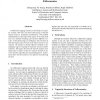146 search results - page 1 / 30 » Representing and sharing folksonomies with semantics |
JIS
2010
13 years 7 months ago
2010
Websites that provide content creation and sharing features have become quite popular recently. These sites allow users to categorize and browse content using ‘tags’ or free-t...
WSDM
2010
ACM
14 years 6 months ago
2010
ACM
Web 2.0 applications have attracted a considerable amount of attention because their open-ended nature allows users to create lightweight semantic scaffolding to organize and shar...
IAT
2007
IEEE
14 years 3 months ago
2007
IEEE
Collaborative tagging systems are becoming very popular recently. Web users use freely-chosen tags to describe shared resources, resulting in a folksonomy. One problem of folksono...
JODS
2006
13 years 9 months ago
2006
Defining and using ontology to annotate web resources with semantic markups is generally perceived as the primary way to implement the vision of the Semantic Web. The ontology prov...
WWW
2007
ACM
14 years 10 months ago
2007
ACM
DBin is a Semantic Web application that enables groups of users with a common interest to cooperatively create semantically structured knowledge bases. These user groups, which we...

